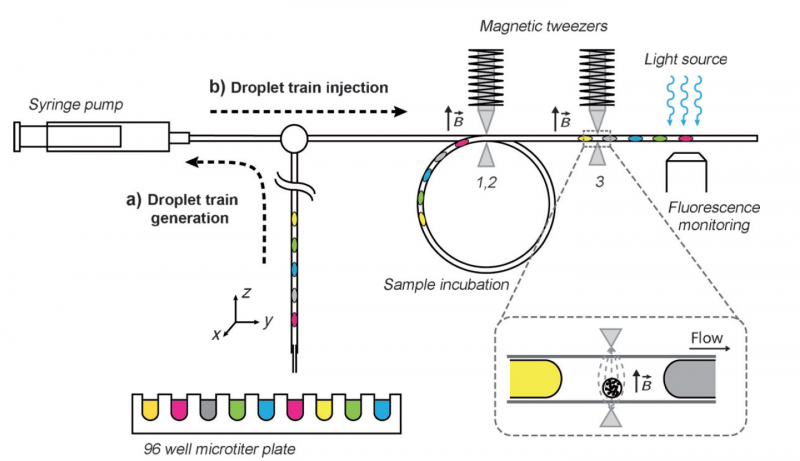We have previously mentioned the topic of microfluidics within this series of articles. Microfluidics deals with the behavior, precise control, and manipulation of fluids that are geometrically constrained to a small, typically sub-millimeter, scale at which capillary penetration governs mass transport. It is a multidisciplinary field at the intersection of engineering, physics, chemistry, biochemistry, nanotechnology, and biotechnology, with practical applications in the design of systems in which low volumes of fluids are processed to achieve multiplexing, automation, and high-throughput screening. Microfluidics emerged in the beginning of the 1980s and is used in the development of inkjet printheads, DNA chips, lab-on-a-chip technology, micro-propulsion, and micro-thermal technologies. We will explain the importance of this technology within the realm of bioprinting below.
The history of microfluidics dates back to the 1970s and the initial inkjet printer systems created. It was known as a fluid handling system for printers. In the 1970s a miniaturized gas chromatograph was realized on a silicon wafer. By the end of the 1980s, the first micro-valves and micro-pumps based on silicon micro-machining had also been presented. Micro-machining refers to the technique for fabrication of 3D and 2D structures on the micrometer scale. In the following years several silicon-based analysis systems have been presented. All these examples represent microfluidic systems since they enable the precise control of decreasing fluid volumes on one hand and the miniaturization of the size of a fluid handling system on the other.
Microfluidics technology can be leveraged well for biochemical and biomedical analysis. This technology initially has been used in these fields for chemical detection. This can be useful for if we want to test a biomaterial for toxicity for example. Toxicity is vital if we want to use a biomaterial for bioprinting purposes. With a contaminated specimen or biomaterial, we are going to harm the body if it is used to replace a kidney for example. We also are using microfluidics to actually print the material, such as a tissue. The tube or pump associated with some bioprinters is based on microfluidic technology. Below is a video of a company that has a microfluidic nozzle based printing system:
The biggest advantages of microfluidic based bioprinting setups include the following:
- Better control of material at a micro material level
- Higher resolution of prints
- Better macroscopic results
- Multi Material usage
Microfluidics allows for better control of material at a micro level due to the precision of a pump or microfluidic tube when it comes to directing the flow of biomaterial to actual printing execution. Due to having such a precise control at the microlevel, systems naturally scale up to the macrolevel and result in extremely nice and high resolution prints. Outside of the resolution and accuracy brought up previously, microfluidic technology allows us to create multi material prints for bioprinting purposes. With microfluidic technology we are able to create our materials within the printer technology itself. There lies no need for laboratory fabrication of the material. A microfluidic chamber can control the mixing of various materials in house. Microfluidics chambers control when two or more opposing materials may be mixed together. Think of them in terms of a dam controlling the flow of liquid.
This technology is still new and rapidly expanding. With the future of biomaterials and bioprinting, we are looking to standardize technology across the spectrum of the field. Microfluidics takes the thought process of old school technology with inkjet printers, but is now merging new and innovative methods within the rapidly growing field of bioprinting. It makes for a lot of interesting things to come as a whole.
Subscribe to Our Email Newsletter
Stay up-to-date on all the latest news from the 3D printing industry and receive information and offers from third party vendors.
Print Services
Upload your 3D Models and get them printed quickly and efficiently.
You May Also Like
Making 3D Printing Personal: How Faraz Faruqi Is Rethinking Digital Design at MIT CSAIL
What if your 3D printer could think more like an intelligent assistant, able to reason through a design idea, ask questions, and deliver something that works exactly the way the...
Reinventing Reindustrialization: Why NAVWAR Project Manager Spencer Koroly Invented a Made-in-America 3D Printer
It has become virtually impossible to regularly follow additive manufacturing (AM) industry news and not stumble across the term “defense industrial base” (DIB), a concept encompassing all the many diverse...
Heating Up: 3D Systems’ Scott Green Discusses 3D Printing’s Potential in the Data Center Industry
The relentless rise of NVIDIA, the steadily increasing pledges of major private and public investments in national infrastructure projects around the world, and the general cultural obsession with AI have...
Formlabs Teams Up with DMG MORI in Japan
In late June, Nick Graham, Chief Revenue Officer at Formlabs, announced on LinkedIn that the company had partnered with DMG MORI, one of the world’s leading machine tool companies, to...



































